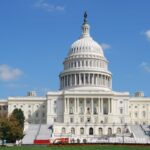Gov. Gavin Newsom wants to throw $11.8 billion of California’s money at climate change and the hazards it poses to the state.
The governor’s gargantuan revised budget proposal, released Friday, includes expenditures to fight and prevent wildfires, combat sea-level rise, put more Californians behind the wheel of an electric vehicle and speed up the transition to a carbon-free electricity grid.
Nearly half of his climate change package — $5.1 billion — would go toward easing the effects of California’s newly-declared drought and remedying long-term water supply problems, such as crumbling canals.
Flush with cash from the Biden administration’s stimulus bill and a better-than-expected COVID-19 economic recovery, Newsom laid out an ambitious suite of proposals designed to slow climate change and protect California from its impact.
Following the most destructive wildfire season in California’s modern history, he’s proposing what his office described as “the single largest investment in wildfire preparedness in our state’s history.” The state would spend $2 billion to carve fuel breaks out of forestlands, help rural residents retrofit their homes against fire, and equip Cal Fire with additional airplanes and helicopters.
There’s also $39 million in “firefighter surge capacity” to hire additional crews for what’s likely to be another difficult season.
Last fall, after a wildfire killed 15 people in the rural Butte County community of Berry Creek, the governor vowed to step up California’s fight against climate change and issued an order phasing out the sale of new gas- and diesel-powered cars by 2035.
His revised budget includes $1.8 billion in the upcoming fiscal year, and a total of $3.2 billion over three years, to put more electric vehicles on the road. That includes the installation of electric charging stations throughout the state.
“These investments will target disadvantaged communities who have disproportionately borne the negative impact of poor air quality,” his administration’s budget document says. He’s also offering $650 million in new rebates to push Californians to go electric, and he’s proposing $1.4 billion over three years to put zero-emission trucks on the road.
Bill Magavern of the Coalition for Clean Air said the rebate money would be particularly important because the state’s annual rebate funding occasionally runs dry, as it did recently.
“It really helps to have incentive dollars, particularly for those folks who would have trouble affording zero-emission vehicles,” Magavern said. “This money will replenish those funds. We’ll be seeing a lot more clean cars, buses and trucks.”
Jared Blumenfeld, the secretary of Cal EPA, said electric vehicles account for 9% of all California car sales, and “we really want to catapult that forward.”
Newsom’s plan also seeks to smooth over the effects of controversial environmental orders with substantial impact on the Central Valley, such as the California Air Resources Board’s decision to prohibit farmers from burning fields and tree limbs by 2025. Newsom would hand out $150 million to help farmers deal with the ban.
The budget also calls for $200 million to seal abandoned oil wells — an expenditure that Natural Resources Agency Secretary Wade Crowfoot would prove crucial as the state moves away from oil production and “our oil fields can be used for other purposes.”
Newsom issued a directive in April to end fracking by 2024 and all oil production — California is one of the leading oil states, after Alaska and Texas — by 2045.
‘California’s efforts to decarbonize the electricity system’
But as more Californians drive electric vehicles, that will put additional burdens on the state’s troubled power grid, which suffered two nights of rolling blackouts during an extraordinary heat wave last summer.
The blackouts exposed a flaw in the state’s drive to remove fossil fuel generation from the grid — namely, that solar power naturally fades after the sun goes down. The state gets one third of its power, on average, from solar and other renewable energy sources.
Newsom has vowed not to retreat from an all-green electric grid, and his new budget includes $350 million to promote energy storage projects — the installation of industrial-strength batteries to bank excess solar power for nighttime use. The budget plan called that expenditure “critical to the success of California’s efforts to decarbonize the electricity system.”
While the funds are intended to slow global warming in the first place, there’s also money to deal with the effects of a planet that will surely continue to heat up. That includes $200 million over two years for coastal wetland restoration, in an effort to deal with projected sea-level rise, and $50 million for weatherization projects in low-income communities.
That Newsom is spending nearly half of his climate change budget on water speaks to the rapid deterioration of drought conditions in recent weeks. The governor on Monday declared a drought emergency for the Central Valley, including greater Sacramento, meaning that 41 of the state’s 58 counties are now officially in drought.
As he outlined Monday, he’s proposing hundreds of millions to help rural Valley communities that are in danger of losing their drinking water as community wells go dry, and billions more for longer-term projects.
That includes $500 million to help towns cope with the economic effect of the Sustainable Groundwater Management Act, which limits groundwater pumping and is expected to permanently idle thousands of acres of farmland, and $200 million to help fix critical canals that have crumbled.
He’s even proposing a $20 million study of whether aqueducts can be covered with solar panels.
___
(c)2021 The Sacramento Bee (Sacramento, Calif.)
Visit The Sacramento Bee (Sacramento, Calif.) at www.sacbee.com
Distributed by Tribune Content Agency, LLC.
—-
This content is published through a licensing agreement with Acquire Media using its NewsEdge technology.



















Allowing proven forest management practices, and forbidding building in fire prone areas, would solve the problem, but, nooooo, that wouldn’t cost enough.
The ecofreaks won’t allow it. I wrote about this problem thirty years ago, it’s nothing new. The solution is preventing or limiting the fires, not finding ways to put them out.
This is why i say LET THE STATE burn.. TAKE out all those eco-freaks running the state into the ground.
How is communist California going to make everyone use electric vehicles, when there will not be enough electricity, through “clean energy” to charge the vehicles. The liberal communist voters in California might as well head for the streets to live with the homeless. There will not be any electricity to cook with, no electricity to heat homes with, no electricity for air conditioning. Liberal voters who vote in these communists are slitting their own throats. Don’t worry communist voters, the heads of Big Tech and the elitists in California, will have all of the energy they need, but the rest of you “useful idiots” will be on the street, with no essentials for living. Haiti, here you come, people of communist California.
I say start WITH all those in office. CRUSH their cars/trucks/suv’s, SEIZE all their private planes and shred them. AND MAKE THEM Travel only via electric cars or horse and buggy..
AND DO the same with all those ninconpoops in pervywood.
These people are so delusional that they now think they can play God. You can throw all the billions and gazillions at Mother Nature you want, but what’s going to happen is going to happen. Newsome, Kerry, Biden, AOC, et al—since you want to follow the science where COVID is concerned, apply the same reasoning to climate. Mankind has zero control over climate so you may as well wake up and learn how to deal with whatever comes along.
And insane pile of **** from and expert in social destruction
considering the remaining California citizens to be gullible
and stupid. Where is this jerk going to get all of these billions,
will the democrat controlled treasury continuing to print money
that dilutes the value of our savings, maybe. The sooner
he is gone the better…….William
Maybe from all the covid bail out that biden and piglosi sent them?
Two things to do: clean up the dead undergrowth in the forested areas, and build reservoirs in the mountains to hold the snow melt each Spring. Reduce the amount of fuel for the fires, whilst simultaneously increasing the amount of water available for all water uses.
Also, use those rubber ball covering the lake, solution, one area did, to help STOP the reservoirs DRYING OUT from evaporating!
Hey Newsom instead of throwing money away on your state why dont you throw yourself in a lake !
That idiot is just trying to buy his way into staying in office. I really wish the big one would hit and float the whole left coast into the middle of the pacific then China could take it over. Just make sure pelosi is in cali when it happens………….
When California finally does break off, it will move north, not west. That makes it Alaska’s problem, not China’s. And we have only a few million years to wait.
TO me, that’s too damn long to wait.. IT should happen THIS YEAR!
You have something against Alaska? ;>}
COMMENTAll OUR TAX$ Isn’t for “Climate Change” because its another DemonRat hoax. Its $$ for their pockets & their special interest. We DO NOT WANT ELECTRIC CARS. STOP FORCING US TO DRIVE THOSE POS CONTRAPTIONS
$20 million for another study. Gee I suppose that will be a Democrat owned study business of course which will not really do any work and tell the Gov. the plan will not work , but still get paid
Reminds me of the Bullet Train to no where..